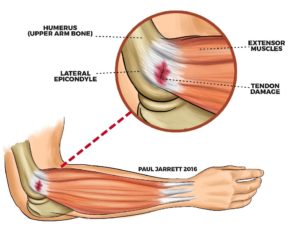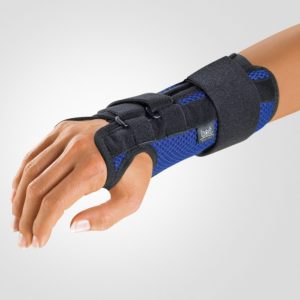Condition and cause
Tennis elbow, also known as lateral epicondylitis or epiconydlalgia, is an overuse injury of the muscles and tendons in the back of the forearm. This causes inflammation, and in some cases micro-tearing, of the tendons in the outer (lateral) elbow. This leads to pain and tenderness in the outer elbow, increased muscle tension and tightness, and can become functionally disabling if it isn’t taken care of or managed. It is common in those between the ages of 35-55 years.

Tennis elbow is becoming more prevalent in workplaces that require intense physical labor due to forceful and repetitive use of the upper limb and awkward postures.
The actions that are typically the cause and also the aggravators of the condition are excessive and repetitive wrist extension, typically in conjunction with elbow extension. For example, someone who is painting a fence with a brush is required to use constant wrist motion for brush strokes.
So while tennis elbow can definitely be caused from playing tennis, we typically see patients with tennis elbow who haven’t been anywhere near a tennis racquet.
How do I know if it’s tennis elbow or something else?
Tennis elbow can be diagnosed through clinical assessment. Tennis elbow can occur from an acute or new injury, or from chronic degeneration of the affected tendons, and so gaining a thorough history of the condition and the person is necessary in determining the most appropriate course of treatment. This may involve finding out about how long you’ve been experiencing pain for, your age, what activities you have been doing lately and/or how many episodes of tennis elbow you’ve experienced in the past.

In some cases, if tennis elbow is left untreated or someone has had pain for a prolonged period of time micro-tearing of the tendons can occur, making it more degenerative/chronic in nature rather than acutely inflamed.
Treatment
So what do we do as therapists managing tennis elbow?
After gaining a thorough understanding of your history of the condition and personal and work factors, rehabilitation can be commenced. This may involve splinting, soft tissue treatment, home exercise programs, heat or cold packs, targeted strengthening, education and LOTS of activity modification.
Tennis elbow can be tricky to settle and can become recurring, so education around activity modification will take up a large component of the rehab.
Splinting – yes or no?
Splinting the wrist can be an important component of managing the pain associated with tennis elbow, as it prevents you from the repetitive wrist motions that can provoke pain – HOWEVER, there is a chance that it can make your symptoms worse should you resist against the splint too much, making your forearm extensors work even harder. This is something you may discuss with your therapist.

Further treatment
Further treatment options may include a cortisone injection, PRP injection, or surgery.
Cortisone injections have been found to provide good short term relief of pain when the tendon is acutely inflamed. However, because this relief can be temporary occasionally a second or third cortisone is completed, which consequently can be damaging for the tendon. It is highly recommended that a cortisone injection is undertaken in conjunction with therapy to prevent re-occurrence.
PRP (Platelet rich plasma) is another alternative treatment for tennis elbow. In order for our tissues to heal, they require adequate blood supply. Tendons have very little blood supply which makes them notorious for slow healing. PRP is taken from your own blood, and filtered to get a concentration of platelets which are then injected back into the elbow to facilitate tendon healing. Platelets are cells in our blood that form clots to prevent bleeding and help wounds heal. They contain growth factors that assist in tendon healing and can reduce pain.
A surgical opinion is indicated if the patient has long-term ongoing pain with associated tearing of the tendons, which cannot be alleviated with conservative treatment or cortisone/PRP injections. For patients who undergo surgical repair of their tendons, post-operative therapy is required to regain mobility and strength.
If you are concerned that you may have tennis elbow, you can make an appointment for a consultation with one of our therapists.
Written by Krystle Pistrin – Practitioner of Hand Therapy
